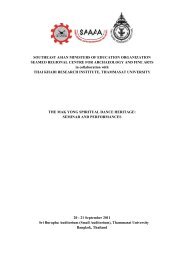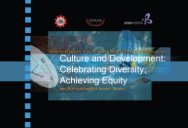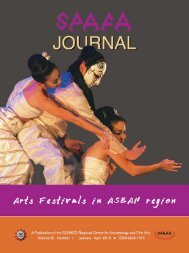on Culture & Development - Seameo-SPAFA
on Culture & Development - Seameo-SPAFA
on Culture & Development - Seameo-SPAFA
- No tags were found...
You also want an ePaper? Increase the reach of your titles
YUMPU automatically turns print PDFs into web optimized ePapers that Google loves.
3) Each group is now instructed to c<strong>on</strong>sider the design of thelog frame for their agreed up<strong>on</strong> project. They should, ifpossible, use post-it notes to write <strong>on</strong> so that they caneasily make alterati<strong>on</strong>s and correcti<strong>on</strong>s.They then proceed to complete the hypothetical orc<strong>on</strong>ceptual log frame matrix.4) During this practice activity remind participants that theymust try to relate each activity or comp<strong>on</strong>ent toownership (who owns the project?) and ask them toc<strong>on</strong>sider how could this be d<strong>on</strong>e. Is there somethingthey could do prior to designing the log frame? See notesbelow.5) Once completed invite a spokespers<strong>on</strong> from each group topresent and explain their respective log frame. The focusshould be <strong>on</strong> people and participati<strong>on</strong>, not the worthinessof the project itself.89Notes <strong>on</strong> Log Frame Design ProcedureIn setting-up the group practice sessi<strong>on</strong> <strong>on</strong> log frame design thefacilitator may wish to c<strong>on</strong>sider suggesting ways or strategiesthat can be employed so that the resulting project document ispeople-focused, culturally-driven, and related to issues ofownership. At stage 4, in the above-listed procedure outline, thiswould be the place where you may want to c<strong>on</strong>sider elicitingsuggesti<strong>on</strong>s from the participants before they proceed tocomplete their log frame matrix.During the course of our workshops, it was decided to see whatstrategies each group devised themselves, without any priorinput. The results were interesting as <strong>on</strong> several occasi<strong>on</strong>sgroups did begin with a ‘role-play’ in which they were the endbeneficiaries and they provided input regarding the problem andproposed soluti<strong>on</strong> from their perspective. This was usually d<strong>on</strong>ein the form of creating problem/soluti<strong>on</strong> trees visually. Thisinformati<strong>on</strong>, when c<strong>on</strong>sidered and then transferred by the










